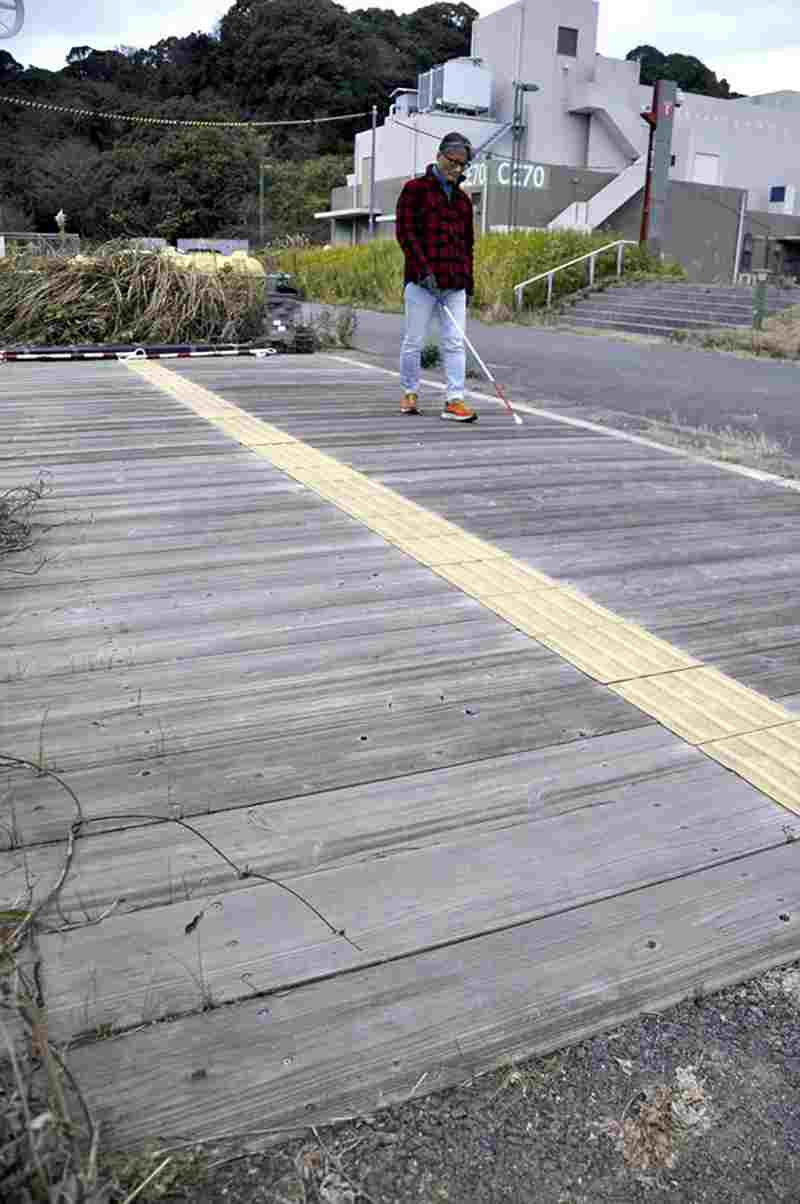Japan’s Kyushu Univ. creates wooden sidewalk that helps the blind and the environment

A prototype cedar sidewalk created the Kyushu University research team led by Associate Prof. Akihiko Higuchi is seen at the Ito campus in Fukuoka City.
10:51 JST, January 16, 2022
FUKUOKA — The idea came to him after his grandmother lost her eyesight. Instead of a sidewalk of asphalt, could one be made with something else that is safer for the visually impaired? The answer was wood, which also made it eco-friendly.
Kyushu University Associate Prof. Akihiko Higuchi is now leading a team that is refining a sidewalk it created using wood from cedar trees, with the aim of preventing the visually impaired from accidentally entering a road by having the sidewalk make a different sound from asphalt when hit with a cane.
The project also incorporates the United Nations Sustainable Development Goals (SDGs) by using wood, as well as by making the underlying beams from recycled plastic bottle caps. By placing the planks of cedar on top of the beams, it creates a cavern under the walkway, enhancing sound that travels through it — such as the tapping of a cane.
As cedar has a certain softness, it also provides a different feeling than walking on asphalt.
Higuchi, who teaches landscape design, started his research in 2007 after his grandmother lost her eyesight due to an illness. At first, the team made a sidewalk with a rough surface, but found it was not much different than a conventional sidewalk. Then on a lark, the team tried a sidewalk like a wooden deck and found it did the trick. They chose cedar as a material as it is relatively easy to procure.
The team carried out an experiment in which 101 visually impaired people were asked to tap on three different sidewalk-like structures with their canes. One was made of concrete, another asphalt, and the third cedar. Ninety-eight of them could distinguish the difference in sound.
In another test on prototype sidewalks, none went out into the road from the cedar sidewalk.
Chizuko Hashiguchi, 71, a participants in the study from Fukuoka, said she had an incident on a sidewalk a year ago. When she tried to go around a car parked on the sidewalk, she lost her sense of direction and didn’t notice when she walked out into the road. A passerby called “Watch out!” and pulled her back.
“It’s easy to recognize because of the sound as I tapped,” Hashiguchi said about walking on the cedar walkway. “It’s also a different feeling while walking, and I would notice if I stepped off it.
“I hope it will be built on streets that are on public transportation routes,” she added.
One problem was with the durability of the wood, as cedar is easily damaged by insects and rot. For that reason, the team used technology developed by Kyushu University to solidify cell walls by injecting resin. Studies show this can prevent decay for more than 20 years.
The technology was put into practical use with the cooperation of the Fukuoka prefectural government and Kyushu Mokuzai Kougyou Co., a company based in Chikugo, Fukuoka Prefecture, that specializes in timber preservation and insect-proofing. The technology was used in renovation work at Itsukushima Shrine, a World Heritage site in Hiroshima Prefecture.
A Kyushu Mokuzai official proudly claims that wood processed with the technology “loses nothing to stone or concrete.”
Higuchi points out that while production costs are twice that of asphalt, there is also the advantage that sections that are damaged can be easily replaced.
The prefectural government has begun studies into implementing the wooden sidewalks, and checked out the prototype at Kyushu University at the end of last year. “We will do research on durability in places where cars will constantly cross over it, and issues related to maintenance,” an official said. “We hope to use it if we can find appropriate places.”
Storing carbon dioxide
From the perspective of SDGs, the sidewalks offer a benefit because they have captured carbon dioxide in the atmosphere and stored it the wood.
According to calculations made by Higuchi’s team, a sidewalk four meters wide and 100 meters long made of cedar wood would weigh as much as 5.6 tons. Of that amount, 2.8 tons is carbon that originated from carbon dioxide in the atmosphere that was captured as the tree grew.
“It can be said that wood sidewalks are storing carbon dioxide captured from the air. Unlike asphalt and concrete, which use large amounts of energy and emit carbon dioxide during the manufacturing process, the more these are put in place, the more they can help combat global warming,” Higuchi said.
Related Tags
"Features" POPULAR ARTICLE
-

Sanrio to Open Museum in Yamanashi Pref. Dedicated to Founder, Exhibits Include Hello Kitty, Other Characters
-

Autumn Foliage Surrounds Visitors to Tokyo’s Showa Kinen Park
-

My Daughter No Longer Speaks to Me, But I Want to See Her and My Grandchild
-

Kumamoto: Public Bath Refurbished as Library Where You Can Chat, Take Photos
-

Frozen Vegetables: Demand Rises for Convenient, Tasty Domestic Produce
JN ACCESS RANKING
-

Tokyo Economic Security Forum to Hold Inaugural Meeting Amid Tense Global Environment
-

Keidanren Chairman Yoshinobu Tsutsui Visits Kashiwazaki-Kariwa Nuclear Power Plant; Inspects New Emergency Safety System
-

Imports of Rare Earths from China Facing Delays, May Be Caused by Deterioration of Japan-China Relations
-

University of Tokyo Professor Discusses Japanese Economic Security in Interview Ahead of Forum
-

Japan Pulls out of Vietnam Nuclear Project, Complicating Hanoi’s Power Plans




























